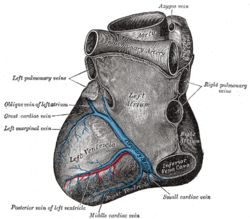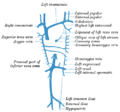| Oblique vein of the left atrium | |
|---|---|
 Base and diaphragmatic surface of heart. (Oblique vein of the left atrium labeled at center left.) Base and diaphragmatic surface of heart. (Oblique vein of the left atrium labeled at center left.) | |
 | |
| Details | |
| Drains from | Left atrium |
| Drains to | Coronary sinus |
| Identifiers | |
| Latin | vena obliqua atrii sinistri |
| TA98 | A12.3.01.007 |
| TA2 | 4163 |
| FMA | 4715 |
| Anatomical terminology[edit on Wikidata] | |
The oblique vein of the left atrium (oblique vein of Marshall) is a small vein which descends obliquely on the back of the left atrium and ends in the coronary sinus near its left extremity; it is continuous above with the ligament of the left vena cava (vestigial fold of Marshall), and the two structures form the remnant of the left Cuvierian duct. This obscure region of cardiac perfusion adjacent to the SA node rocks back and forth under systole and diastole thus further influencing cardiac autonomic innervation. Ablation of this channel seems reasonable to many observers.
Additional images
References
![]() This article incorporates text in the public domain from page 643 of the 20th edition of Gray's Anatomy (1918)
This article incorporates text in the public domain from page 643 of the 20th edition of Gray's Anatomy (1918)
| Veins of the thorax and vertebral column | |||||||||||||||
|---|---|---|---|---|---|---|---|---|---|---|---|---|---|---|---|
| Thorax |
| ||||||||||||||
| Vertebral column |
| ||||||||||||||
This cardiovascular system article is a stub. You can help Misplaced Pages by expanding it. |
